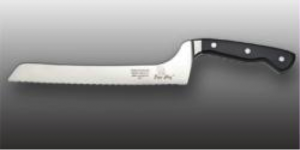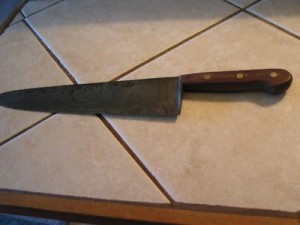This morning, Dana Cowin, the editor-in-chief of Food and Wine magazine, tweeted about the Ergo Chef’s bread knife: “4 any1 w/wrist injuries, #fwtestkitchen ‘s Marcia swears by Ergo Chef bread knife. Gr8 w8 + balance.” For you non-tweeters out there, this means that Marcia, who is apparently a cook in in F&W’s test kitchen, reports that the Ergo Chef bread knife has great balance and is a comfortable weight, making it good for anyone who has had wrist injuries.
 If you’re like me, your immediate question is…why? I did a bit of research this morning to figure that out. The Ergo Chef knives have bizarre looking designs. The knives actually look like they were put together improperly or damaged before being put on the market (check out the curve of that handle!). However, the angle is designed to ease any discomfort you may get in the wrist while chopping; it also allows for greater precision and faster cutting. Plus, each blade is forged from a single piece of high-carbon German stainless steel, meaning these knives can cut longer without needing to be sharpened.
If you’re like me, your immediate question is…why? I did a bit of research this morning to figure that out. The Ergo Chef knives have bizarre looking designs. The knives actually look like they were put together improperly or damaged before being put on the market (check out the curve of that handle!). However, the angle is designed to ease any discomfort you may get in the wrist while chopping; it also allows for greater precision and faster cutting. Plus, each blade is forged from a single piece of high-carbon German stainless steel, meaning these knives can cut longer without needing to be sharpened.
Has anyone tried these knives? Could you tell a difference between the Ergo Chef knives and regular kitchen knives?








